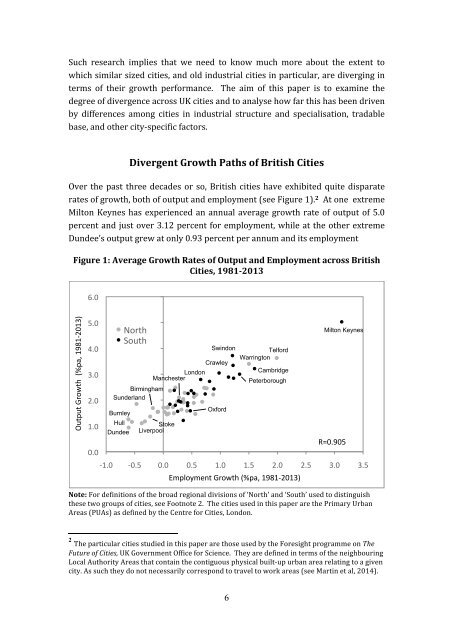Divergent Cities In Post-Industrial Britain
2nWshbq
2nWshbq
Create successful ePaper yourself
Turn your PDF publications into a flip-book with our unique Google optimized e-Paper software.
Such research implies that we need to know much more about the extent to <br />
which similar sized cities, and old industrial cities in particular, are diverging in <br />
terms of their growth performance. The aim of this paper is to examine the <br />
degree of divergence across UK cities and to analyse how far this has been driven <br />
by differences among cities in industrial structure and specialisation, tradable <br />
base, and other city-‐specific factors.<br />
<strong>Divergent</strong> Growth Paths of British <strong>Cities</strong> <br />
Over the past three decades or so, British cities have exhibited quite disparate <br />
rates of growth, both of output and employment (see Figure 1). 2 At one extreme <br />
Milton Keynes has experienced an annual average growth rate of output of 5.0 <br />
percent and just over 3.12 percent for employment, while at the other extreme <br />
Dundee’s output grew at only 0.93 percent per annum and its employment <br />
Figure 1: Average Growth Rates of Output and Employment across British <br />
<strong>Cities</strong>, 1981-2013 <br />
)"!#<br />
+,-.,-#/012-3##45.67#$89$*%!$&:#<br />
("!#<br />
'"!#<br />
&"!#<br />
%"!#<br />
$"!#<br />
!"!#<br />
A10-3#<br />
B1,-3#<br />
Swindon<br />
Telford<br />
Warrington<br />
Crawley<br />
London<br />
Cambridge<br />
Manchester<br />
Peterborough<br />
Birmingham<br />
Sunderland<br />
Burnley<br />
Hull<br />
Dundee<br />
Stoke<br />
Liverpool<br />
Oxford<br />
*$"!# *!"(# !"!# !"(# $"!# $"(# %"!# %"(# &"!# &"(#<br />
;


